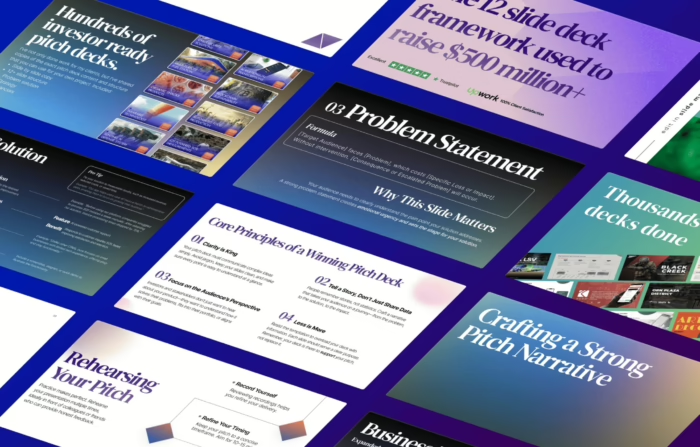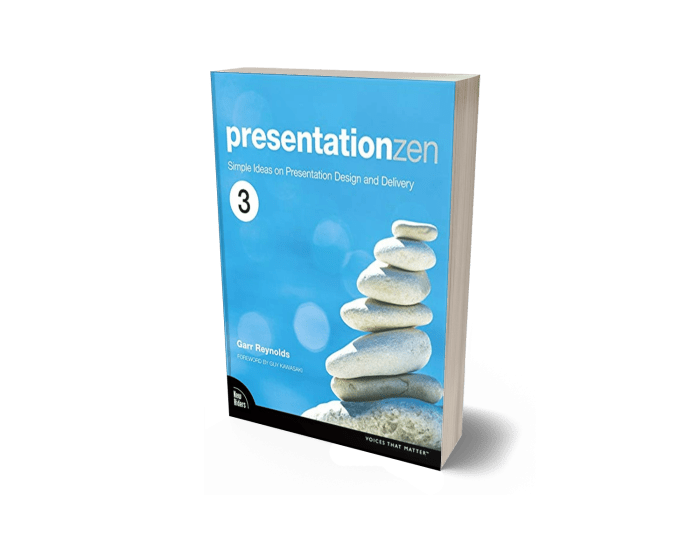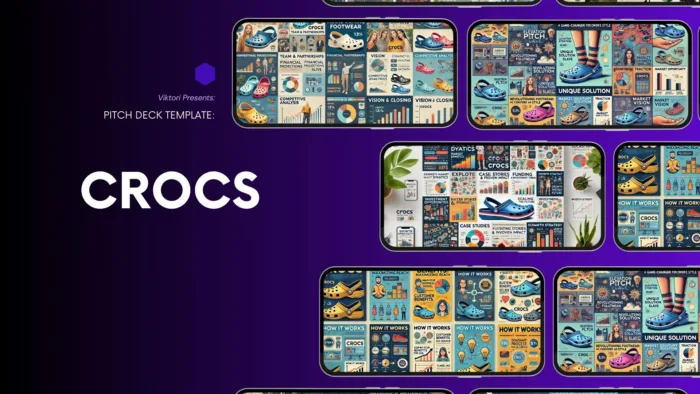Hey there. Let’s get real for a second. If you’re here, you’re likely thinking about taking on the giants of the CPG world or making a name for yourself in a space dominated by familiar brands. The good news? You’ve got something they don’t—a fresh perspective, a product that stands out, or a story that’s begging to be told. The bad news? None of that matters unless you can pitch it right.
I’m Viktor, a pitch deck expert and creative business strategist. Over the past 13 years, I’ve helped businesses secure millions of $ in funding thanks to my approach and I’m sharing it here in this pitch deck guide.
Now, let’s face it: Most CPG pitches fall flat, not because the products aren’t great but because the presentation… well, sucks. It’s not that you’re not putting in the effort. You’re just pitching like it’s 2010 and expecting 2024 results. But don’t worry. I’ve seen it all, and I’m here to help you flip the script. Let’s make your pitch irresistible, whether you’re gunning for funding, partnerships, or just trying to get that “hell yes” from your audience.
You ready? Let’s dive in.
Get My 12 Slide Framework That Got $500mil in Funding For Clients.
What do you think of having 12 dead simple formulas, that will help you craft 12 slides, in about 1 hour? That’s what you’ll get, when you download my 12 slide framework. Save hours crafting your pitch deck copy with my tested approach that includes:
- Elevator pitch one sentence formula
- Problem/ solution slide one sentence formula
- Competitor slide one sentence formula
- 9 other formulas, tips, tricks and advice
The formulas worked for 40+ industries and 500+ companies. Including the one you’re looking at now.
Clicking the link won’t charge you anything.

Get an investor ready pitch deck that gets you funded and saves over 30 hours of your time.
Join 100s of successful entrepreneurs who’ve transformed their pitch decks by using my hands-off approach, which includes: market research, copy, design, financials, narrative and strategy.
1 week turnaround time and less. Special pricing for early stage companies.
The least you will get on this call is 10 actionable tips & strategies to own that next pitch, worth $599, for free.

15 Slide CPG brands pitch deck template | Google Slides
The above is is just a simplified pitch deck version developed as part of our entrepreneurship program for graduate studies.
Founders that are serious about getting the funding they need, opt in for a deck has industry specific content, superb narrative and award winning design like these ones below:









I can help you build that deck with my hands-off process in 7 days or less.
Book a free 30 minute call below if you’re serious about getting an investor ready deck, and we’ll discuss your needs in detail. I’ll help you design the deck, write the content, develop the narrative and flesh out the strategy with financials.

We help 15,000+ founders every month create better pitch decks.
Alternatively, get the custom template for just $69,99.As soon as the payment is processed I’ll send over a quick questionnaire and deliver the deck in 24 hours and less.

Follow us on social for the newest templates:
1. Cover Slide
Visuals:
- A high-resolution image of your brand logo prominently placed in the center or top of the slide.
- A background color or image that aligns with your brand’s theme or the primary color of your product packaging.
Content:
- Brand Name: Clearly written, possibly in a larger font.
- Tagline or Slogan: A catchy phrase that encapsulates the essence of your brand or product. For instance, if you’re selling an organic snack, a tagline could be “Nature’s Crunch in Every Bite!”
- Date: The date of the presentation.
2. Introduction
Visuals:
- A collage or a sequence of images showcasing the early days of the brand, the team, or the inspiration behind starting the brand.
- If possible, a short video clip or animation that tells a brief story of the brand’s inception.
Content:
- Founder’s Story: A concise narrative about why you started the brand. This could be a personal story, an observation, or a passion that led to the creation of the product.
- Example: “Growing up in a small town, I realized the lack of healthy snack options. This inspired the creation of [Brand Name].”
- Mission: A statement that describes the brand’s purpose and what it aims to achieve.
- Example: “To provide healthy and delicious snacks that everyone can enjoy without guilt.”
- Vision: A statement that outlines the brand’s aspirations for the future.
- Example: “To be the leading choice for health-conscious snackers across the country.”
3. Problem Statement
Visuals:
- Graphs or charts showing market research data that highlights the problem.
- Images or illustrations that depict the problem in a relatable manner.
Content:
- Market Gap: Clearly define the problem or gap in the market that your product addresses.
- Example: “Despite the growing health trend, 70% of snacks in the market are still loaded with artificial additives and sugars.”
- Significance of the Problem: Explain why addressing this problem is crucial. This could be based on health concerns, changing consumer preferences, or any other relevant factor.
- Example: “With rising health issues and a more informed consumer base, there’s a pressing need for genuinely healthy snack options.”
4. Solution
Visuals:
- High-quality images or a short video of your product, showcasing it from different angles.
- Infographics highlighting the unique features or ingredients of your product.
Content:
- Product Introduction: A brief description of your CPG product.
- Example: “Introducing [Product Name], the all-natural, no-preservatives snack that’s both delicious and nutritious.”
- Unique Selling Points (USPs): List the main features that set your product apart from competitors.
- Examples: “Gluten-free, No artificial colors, Sourced from organic farms, Recyclable packaging.”
5. Product Overview
Visuals:
- Detailed images of the product, possibly showing the inside or the texture, if relevant.
- If there are multiple variants, a collage or a sequence showcasing each variant.
- Graphics or icons representing key ingredients or features.
Content:
- Product Description: Dive deeper into what makes your product special. Discuss ingredients, flavors, sizes, or any other relevant details.
- Example: “Our snacks come in three flavors: Almond Delight, Berry Blast, and Chocolate Crunch. Each pack is 100g, perfect for an on-the-go treat.”
- Packaging and Design: Highlight the thought process behind the packaging, especially if it’s sustainable or innovative.
- Example: “Our packaging is made from 100% recycled materials, ensuring our commitment to the environment.”
6. Market Opportunity
Visuals:
- Graphs or charts showing market size, growth trends, and potential.
- A map highlighting target markets or regions.
Content:
- Target Market Size: Provide data on the potential number of consumers or the value of the market segment you’re targeting.
- Example: “The healthy snack market is valued at $5 billion, with a 10% growth rate annually.”
- Market Trends: Discuss current trends that support the need for your product.
- Example: “There’s a 15% increase in consumers seeking organic products in the last year alone.”
- Competitive Landscape: Briefly touch upon the competition, but frame it in a way that showcases the gap your product fills.
- Example: “While there are other healthy snacks, none combine the taste, nutrition, and sustainability that [Brand Name] offers.”
7. Business Model
Visuals:
- A flowchart or diagram illustrating how your business operates from production to sales.
- Icons representing different revenue streams or distribution channels.
Content:
- Pricing Strategy: Explain the rationale behind your product’s pricing, considering factors like production costs, competitor pricing, and perceived value.
- Example: “Our snacks are priced at $4.99 per pack, offering premium quality at an affordable rate.”
- Distribution Channels: Detail where and how customers can purchase your product.
- Example: “Available online through our website, major e-commerce platforms, and in select health food stores nationwide.”
- Revenue Streams: Highlight the primary ways your business generates income.
- Example: “Direct online sales, wholesale to retailers, and partnerships with fitness centers.”
Hold on. You might want to check my list on the best presentation and communication books...
These are crucial books that will help you improve the design and structure of your decks and presentations, besides improving your delivery and skyrocketing your confidence when facing investors. Check them out below.

8. Go-to-Market Strategy
Visuals:
- A timeline showcasing the rollout plan.
- Images or mock-ups of marketing materials, advertisements, or promotional events.
Content:
- Marketing and Advertising Plans: Outline your strategies for creating brand awareness and driving sales.
- Example: “Launching a social media campaign with influencers, targeted ads on health blogs, and free sampling at local gyms.”
- Retail Partnerships: If you have existing partnerships or are in talks with retailers, mention them here.
- Example: “In discussions with Whole Foods and Trader Joe’s for shelf placement in the organic section.”
- Promotions and Launch Strategy: Describe any special promotions or events planned for the product launch.
- Example: “First 100 online orders receive a complimentary snack box. Hosting a launch event with nutritionists and fitness experts.”
9. Traction
Visuals:
- Graphs showing sales growth or other key metrics over time.
- Photos from past events, customer reviews, or media mentions.
Content:
- Sales Figures: Share any impressive sales numbers or growth rates that demonstrate market interest.
- Example: “Sold 20,000 units in the first month with a 25% month-over-month growth rate.”
- Key Milestones: Highlight significant achievements, such as awards, certifications, or notable partnerships.
- Example: “Awarded ‘Best New Snack’ at the National Health Foods Convention 2023.”
- Customer Testimonials: Showcase positive feedback from customers to build credibility.
- Example: “I’ve never tasted a healthier snack that’s this delicious!” – Jane Doe
10. Financial Projections
Visuals:
- Bar graphs or line charts showing projected revenue and profit for the next 3-5 years.
- Pie charts breaking down costs (production, marketing, operations).
Content:
- Projected Revenue: Provide estimates for your expected sales over the next few years.
- Example: “Projected to reach $2 million in revenue by 2025.”
- Profit Projections: Highlight the expected profit margins and net profit.
- Example: “Anticipated profit margin of 30% by 2024.”
- Cost Breakdown: Offer a brief overview of major expenses.
- Example: “Major costs include production (40%), marketing (30%), and operations (20%).”
11. Ask
Visuals:
- Imagery that evokes partnership, growth, or investment.
- Icons representing different aspects of your ask, such as funding, shelf space, or collaborations.
Content:
- Retailer Ask: Clearly state what you’re seeking from retailers.
- Example: “Seeking premium shelf space in 50 stores with a promotional display for the first month.”
- Investor Ask: Specify what you’re looking for from investors.
- Example: “Raising $500,000 in exchange for a 10% equity stake in the company.”
12. Testimonials & Success Stories
Visuals:
- Photos of satisfied customers or partners, ideally interacting with your product.
- Quotation marks or design elements that highlight the testimonials.
Content:
- Customer Quotes: Showcase genuine feedback from customers that underscores the value and quality of your product.
- Example: “I can’t get enough of [Product Name]! It’s become a staple in my daily diet.” – Alex R.
- Success Stories: Share anecdotes or case studies of successful partnerships, collaborations, or any significant milestones achieved due to customer feedback.
- Example: “After partnering with a local gym, our sales in the area increased by 50% in just two months.”
13. Team
Visuals:
- Professional photos of key team members.
- Icons or graphics representing each member’s role or expertise.
Content:
- Team Profiles: Briefly introduce key team members, highlighting their roles, experience, and any significant achievements.
- Example:
- “Jane Smith – CEO: With 10 years in the CPG industry, Jane previously led marketing at [Famous Brand], increasing their sales by 20% in two years.”
- “John Doe – CTO: A food scientist with patents in sustainable packaging, John ensures our products are both tasty and eco-friendly.”
- Example:
- Relevant Experience: Emphasize any collective achievements or experiences of the team that make them uniquely suited to succeed.
- Example: “Our team collectively has over 30 years of experience in the CPG sector, with members having worked at [Industry Leaders].”
14. Conclusion & Thank You
Visuals:
- A recap image or collage that encapsulates the essence of your brand and product.
- Your brand logo, prominently displayed.
Content:
- Recap: Summarize the main points of your pitch in a few bullet points or sentences.
- Example: “With a unique product, a growing market, and a dedicated team, [Brand Name] is poised to revolutionize the healthy snack industry.”
- Contact Details: Provide information for follow-up, including email, phone number, and any relevant social media handles.
- Thank You: Express gratitude for the time and attention of your audience.
- Example: “Thank you for considering [Brand Name]. We’re excited about the possibility of partnering with you.”
15. Appendix (Optional)
Visuals:
- Any additional charts, graphs, or images that support your pitch but didn’t fit into the main presentation.
Content:
- Additional Data: Provide any supplementary data or research that might be relevant for specific questions or deeper dives.
- Example: “Detailed breakdown of production costs, third-party lab test results, sustainability impact report.”
- FAQs: Anticipate and answer some potential questions that retailers or investors might have.
- Example: “Why did we choose our specific packaging? How do we source our ingredients sustainably?
Last Words
Alright, so we’ve walked through the key elements of pitching your CPG brand. Now, you’ve got the blueprint. But here’s the thing—no deck, no matter how perfectly designed, is going to carry you across the finish line alone. You need to bring the energy, the passion, and the ability to adapt on the fly. Investors and partners aren’t just buying into your product; they’re buying into you.
So, go out there, own the room, and remember: it’s not just about selling a product; it’s about convincing them that you’re the one who’s going to take this idea to the next level.
You got this!
But if you don’t got it:
Join hundreds of successful entrepreneurs who’ve transformed their pitch decks with my help.
Let me develop an investor ready deck by using my hands-off approach, which includes: market research, copy, design, financials, narrative and strategy.
One week turnaround time.
The least you will get is 10 actionable tips & strategies to own that next presentation, worth $599, for free.

Related FMCG Pitch Deck Templates
14 Slide CROCS Pitch Deck Template
So, you’ve got a knack for spotting the coolest footwear trends and you’re ready to…
13 Slide FMCG Pitch Deck Template
So, you’ve got a killer product that could be the next big thing in the…
15 Slide CPG Brand Pitch Deck Template
Hey there. Let’s get real for a second. If you’re here, you’re likely thinking about…
Looking for a step by step guide to build an FMCG pitch deck?
Check out our in-depth pitch deck guide.
Check out some of the essential 101 guides:
The Role of Emotional Storytelling in Pitch Decks
Why Color Psychology in Pitch Decks Matters More Than You Think
This is the ideal pitch deck length + exact slides Author: ViktorPitch Deck Expert. Ex…
How to Design a Visually Stunning Investor Pitch Deck + Template
This is the ideal pitch deck length + exact slides
This is the ideal pitch deck length + exact slides Author: ViktorPitch Deck Expert. Ex…
Mastering the Financial Projections Slide: Turning First Impressions into Lasting Opportunities
You’re convinced your startup is the next big thing, but somehow, your pitch keeps landing…
Creating an Impactful Traction Slide for Your Investor Pitch Deck: A Startup Guide
You’ve got the next unicorn startup brewing, but here’s the harsh reality: your traction slide…










